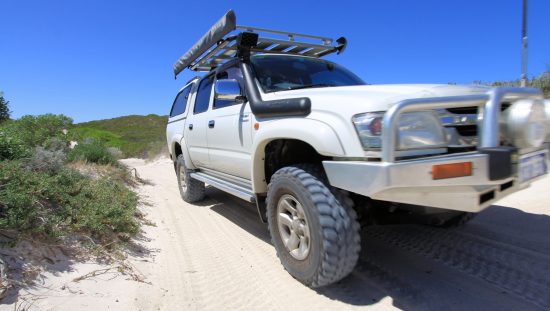
4x4 Vehicle Winch General Rigging:
General 4x4 Vehicle Winch tips:
Before taking on a deep bog hole or even a tough hill climb which there is a fair possibility of getting stuck, getting the winch rope out and wrapping it around the front bar is a good idea. This allows for a faster recovery and saves your mates from having search for the winch hook and rope under mud.
If having to unwind the entire winch for cleaning, untangling or just to neaten up the rope on the drum a weight/force should be used for winding it back in.
A weight/force can be anything like anchoring to a tree and pulling the vehicle towards it or even pulling another vehicle towards you. If using another vehicle make sure that vehicle applies the brakes lightly to create extra force.
The first 10 meters of rope from the hook can just be rolled on without resistance, the first ten meters is always pulled out before most recoveries.
Must know details and tips regarding Re-spooling electric winch rope see electric winch.
When using the vehicle winch during heavy loads (perhaps the 4x4 is stuck in sticky mud or it’s a very steep hill) it’s best to let the winch cool down after 20-30 sec intervals.
Letting it cool for about 20 seconds and then winching for 20 seconds
will reduce wear and help prevent burning out the 4x4 winch. It will also help
prevent the drum from getting too hot and melting the rope.
Regularly use a water displacement spray (RP7 or WD40) and spray the switch
plug connection to help prevent rust from gathering.
After a water crossing deep enough to submerge the winch, its good practice to
run the winch out and back in about 10 meters worth of rope to evaporate and
water which may have entered the winch drum/motor.
General rigging:
Single line pull is the most common way to winch and the most simple; this is done by pulling out the 4x4 vehicle winch rope/cable and connecting the hook to an anchor point.
Anchor points can be anything from another vehicles recovery
point, a tree by using a tree truck protector, a sand anchor or sometimes a big
rock.
Once hooked up place a winch rope damper over the rope/cable just before under tension (just before as being around/near the rope under full tension is dangerous and should be avoided at all cost). The winch damper will help force the rope or cable to the ground if it should snap/break, it also makes it clear where the rope is.
If winching off a tree a trunk protector (tree trunk strap) must be used, this will prevent ring barking (killing the tree) and will prevent damaging the recovery gear.
Always use a live tree which is big and solid, a dead tree could be pulled down onto the vehicle and the same will happen if the tree is too small.
When tensioning the rope place the tree trunk protector as close to the base of the tree as possible, only put it up further on the tree if you have no choice.
Reasons for placing the anchor point further up the tree are;
# To get the rope off the ground to prevent damaging it.
# Needing to pull upwards to prevent vehicle damage (pulling a 4x4 directly into an obstacle which is solid or won't move can cause unnecessary stress to the recovery and possibly damage the vehicle).
When pulling/winching off a tree more than 1 meter off the base/tree roots wrap the trunk protector around the tree to prevent it from suddenly sliding down which can happen if there is some slack in the winch rope at some stage.
Using another vehicle as an anchor is the most common 4x4 winch procedure, this is mainly due to the fact a vehicle can be moved around to improve the winching direction, distance and trees are not always around.
Sometimes when a vehicle is really stuck the force required can be too much and will pull the anchor vehicle towards the stuck 4x4, even with hand brake, foot brake applied and a wheel chock it just isn't enough sometimes.
To prevent this have a third vehicle behind the anchor vehicle attached with a winch or extension strap so it creates double the anchor weight. If no third vehicle a lucky placed tree can do the job as well.
If familiar with general winching see the advanced 4x4 vehicle winch rigging for some good tips and pointers.
Advanced 4x4 vehicle winch rigging:
Only once understanding & mastering general winching should the following
4x4 winch rigging be considered.
What is advanced winching?
Advanced winching is directional pulls, double line pull, triple line+ pull,
winching backwards downhill and complex winching on tight tracks involving
multiple directional pulling.
The main additional tools required here is of course a 4x4 winch, a snatch block, multiple anchor points and multiple recovery points! Without these no advanced winching is safely possible.
Follow this link for Advanced 4x4 winching rigging and tips.
Recent Articles
-
Goodyear wrangler MTR
Jun 28, 24 10:27 PM
I have these on my defender 90 and my Dmax Ute. I get around 100,000 km out of them. I tried AT for one change and went back to the MTs. They are gol -
4x4 off road tracks 0 to 250 km from Perth
Nov 21, 23 07:40 PM
On this page we cover 4x4 off road tracks within a 250 km radius from Perth... -
4 Wheeling Around Jurien Bay.
Nov 21, 23 07:35 PM
Jurien Bay 4x4 tracks info and general information about the area...
- Home
- 4x4 Recovery
- 4x4 Winch
- Vehicle Winch
Leave Vehicle Winch And Go 4 Wheeling In Western Australia.







